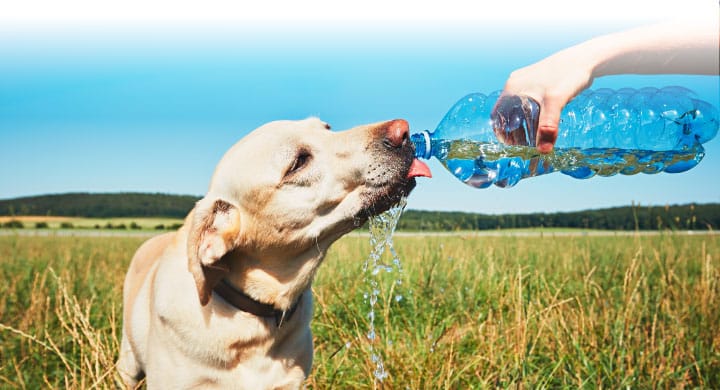Who doesn\’t love summer? The sun is soaring, high in the sky, beckoning us all out to the beaches, BBQs, and all the fun-filled vacation spots. You\’re happy because work is slowing down. The kids are happy because school\’s out. The dog is happy because all of a sudden, everyone\’s home! But as we crank our A/Cs up and take cover in the shade, it\’s important to watch out for dog heat stroke signs. A dog\’s coat is suitable to keep a dog warm through the blistering winter, but many dogs are susceptible to heat stroke if we\’re not careful.
Dogs with squishy faces ( brachycephalic) like Pugs and Shar-Peis are extra sensitive to hot weather because of their anatomy. Nordic dogs with double coats like Pomeranians and Huskies may also have a hard time cooling off. Yet all breeds can be affected by heat stroke. When taking long walks or playing at the dog beach, watch for signs of heatstroke. If your dog begins to overheat there are some easy ways to quickly cool them down before things get out of hand.
Don\’t let the sun keep you away from the summer fun! This article will show you dog heat stroke signs and the best way to prevent overheating.
What is Heat Stroke?
There are two veterinary risks to dogs exposed to an overabundance of heat. The first is hyperthermia, which is an elevation in body temperature that exceeds the accepted normal range. This is different than hypothermia, which is when a dog loses more body heat than can be produced. A healthy dog\’s body temperature floats between 101° to 102.5° degrees Fahrenheit (38.3° to 39.2° Celsius). So any temperature reading over a 103° Fahrenheit (39° Celsius) is in the hyperthermia range.
Heat stroke is characterized as either non-fever hyperthermia that takes place when a dog\’s heat regulating body mechanisms of the body cannot accommodate the excess body heat. Veterinarians state that a heat stroke sets in at 106° (41°C) or above. When a dog\’s internal temperature gets this high this can lead to organ dysfunction or worse organ failure.
A fever hyperthermia develops with inflammation occurring in the body similar to the kind that a bacterial infection would produce. Non-fever occurs without signs of inflammation when a dog is overheated. All non-fever hyperthermia results from increased body temperature. Other causes of non-fever hyperthermia include excessive exercise, disproportionate levels of thyroid hormones, or lesions in the hypothalamus—a region in the brain that regulates the nervous system. The hypothalamus controls body temperature and other bodily mechanics.
Dog Heat Stroke Signs to Watch For
Heavy Panting
Every dog lover knows that instead of sweating a dog cools himself down by panting. Moisture is drawn from air passing over a dog\’s tongue that circulates cooling down their body. Dogs do sweat through their paws to rid their bodies of heat but this is not the primary way of ventilating.
During the hot summers, a dog will usually pant regularly. There are stages of panting that show dog owners their dog is overheating. What pet parents need to watch for is excessive and heavy panting. Typical panting begins with a slightly parted mouth while your dog pants rhythmically. As their internal body temperature increases, the degrees of panting look more extreme. When a dog opens their mouth wide, with a swollen tongue hanging out to the side, this is one the first dog heat stroke signs. If your dog is salivating and drooling excessively this is also a red flag.
Fast or Irregular Heart Beats
Another sign your dog might be overheating is racing or irregular heartbeat. When a dog\’s heart rate increases this is the body\’s defense from the heat. The blood flow is pumped to the limbs away from any vital organs where damage can occur. If you need to check your dog\’s heart rate on the spot without veterinary assistance put your hand to your dog\’s chest. Count how many pulses you feel in 15 seconds, then multiply this number by four. A normal heart rate is between 60 and 140 beats per minute.
Dog Heat Stroke Signs Include:
- Red Gums
- Non-Production of Urine
- Sudden Kidney Failure
- Shock
- Heart & Lung Failure
- Vomiting Blood
- Blood in Stool
- Seizures
- Lethargy
- Muscle Tremors
- Uncoordinated Movement
- Unconsciousness
If you observe your dog showing any signs of heat stroke, get veterinary service immediately!
What Causes Overheating in Dogs?
Heat stroke is easy to prevent and the primary cause is severe environmental heat and humidity. This can happen when a dog is left outside all day, in a hot car, ventilated room, and a groomer drying cage. All these situations can be avoided and are a result of carelessness.
Another cause of heat stroke is upper airway disease which interferes with normal breathing. When airflow is constricted, this impedes a dog\’s ability to circulate air to cool down. Other culprits of heat stroke are diseases like paralysis of the voice box (larynx), heart or blood vessel disease, and nervous-system disease.
Poisoning can also lead toward seizures and an abnormal increase in body temperature which are dog heat stroke signs. Poisonous compounds found in pesticides made with strychnine, which kills small vertebrates, are very harmful to dogs.
Lastly, any dog that is exercising in the heat needs to be monitored closely. Heat exacerbates a dog’s temperature and when they are exerting themselves in hot temperatures they will need breaks to cool down.
Preventing Heat Stroke is Simple; Here\’s How
Lucky for pet parents, like most dangers, heat stroke is easy to prevent. Before dog heat stroke signs even show up there are steps we can all take to keep our dogs safe.
The most common scenario of dog heat stroke is leaving a poor pup in the car on a hot summer day. Even with the windows cracked, car temperatures can reach life threatening sweltering conditions quickly. Pet owners should also make sure dogs aren\’t overexposed to hot temperatures without access to fresh water and shade. Even long walks in the sun can be hazardous. Dogs that are more susceptible to temperature (the squishy-faced ones) like Pugs, Bull Dogs, Shih Tzu etc. will need plenty of ventilation.
The two easiest ways of keeping your dog’s temperature in a healthy range are providing cool water and shady areas.
Pet Care for an Overheated Dog
If you begin noticing dog heat stroke signs get your dog into a cooler environment immediately. Contact a veterinarian and in the meantime, there are steps you can take to get their temperature back to normal.
Put your dog in a cool bath tub or run hose water over their coat. Take care to make sure your dog\’s head is thoroughly coated with water. If your dog is unconscious ensure water does not enter their nose or mouth. If needed you can apply a frozen pack to their head only. Make sure the water is cool but not cold. Overly cold water will actually counteract a dog\’s cooling process, but a package of frozen veggies on their head helps.
Massaging your dog\’s legs is also helpful. Rubbing their legs will stimulate blood circulation which will prevent shock. Of course, during all these steps, let your dog drink as much fresh water as he wants. Adding a small pinch of salt to his dog bowl will also replace any minerals he\’s lost while panting.
Veterinary Care
If your dog\’s heat stroke case is severe a vet treatment will replace lost fluids and minerals. This will be done through intravenous fluid therapy. A vet will also most likely check for secondary complications like kidney failure, brain injury, abnormal clotting, changes in blood pressure, and amount of electrolytes.
Play Safe!
Keeping our dogs safe is an easy task because they\’re so cute and we love them so much! On hot days, simple common sense is the best way to prevent heat stroke. Teach your family to spot dog heat stroke signs so you all can enjoy the summer!
Follow Splash and Dash Groomerie & Boutique:
- Website: http://splashanddashfordogs.com/
- Website: https://splashanddashfranchise.com/
- Facebook: https://www.facebook.com/splashanddashfordogs/
- Instagram: @splashanddashfordogs
- LinkedIn: https://www.linkedin.com/in/dan-j-barton-622ab517
- Twitter: splashanddash4dog



